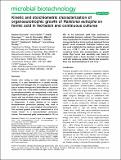[clc] Kinetic and stoichiometric characterization of organoautotrophic growth of Ralstonia eutropha on formic acid in fed-batch and continuous cultures
Author(s)
Grunwald, Stephan; Mottet, Alexis; Grousseau, Estelle; Plassmeier, Jens K.; Uribelarrea, Jean-Louis; Gorret, Nathalie; Popovic, Milan K.; Guillouet, Stephane E.; Sinskey, Anthony J; ... Show more Show less
DownloadGrunwald-2014-Kinetic and stoichio.pdf (284.3Kb)
PUBLISHER_CC
Publisher with Creative Commons License
Creative Commons Attribution
Terms of use
Metadata
Show full item recordAbstract
Formic acid, acting as both carbon and energy source, is a safe alternative to a carbon dioxide, hydrogen and dioxygen mix for studying the conversion of carbon through the Calvin–Benson–Bassham (CBB) cycle into value-added chemical compounds by non-photosynthetic microorganisms. In this work, organoautotrophic growth of Ralstonia eutropha on formic acid was studied using an approach combining stoichiometric modeling and controlled cultures in bioreactors. A strain deleted of its polyhydroxyalkanoate production pathway was used in order to carry out a physiological characterization. The maximal growth yield was determined at 0.16 Cmole Cmole[superscript −1] in a formate-limited continuous culture. The measured yield corresponded to 76% to 85% of the theoretical yield (later confirmed in pH-controlled fed-batch cultures). The stoichiometric study highlighted the imbalance between carbon and energy provided by formic acid and explained the low growth yields measured. Fed-batch cultures were also used to determine the maximum specific growth rate (μ[subscript max] = 0.18 h[superscript −1]) and to study the impact of increasing formic acid concentrations on growth yields. High formic acid sensitivity was found in R eutropha since a linear decrease in the biomass yield with increasing residual formic acid concentrations was observed between 0 and 1.5 g l[superscript −1].
Date issued
2014-08Department
Harvard University--MIT Division of Health Sciences and Technology; Massachusetts Institute of Technology. Department of Biology; Massachusetts Institute of Technology. Engineering Systems DivisionJournal
Microbial Biotechnology
Publisher
Wiley Blackwell
Citation
Grunwald, Stephan, Alexis Mottet, Estelle Grousseau, Jens K. Plassmeier, Milan K. Popovic, Jean-Louis Uribelarrea, Nathalie Gorret, Stephane E. Guillouet, and Anthony Sinskey. “ Kinetic and Stoichiometric Characterization of Organoautotrophic Growth of R Alstonia Eutropha on Formic Acid in Fed-Batch and Continuous Cultures .” Microbial Biotechnology (August 13, 2014): n/a–n/a.
Version: Final published version
ISSN
17517915
17517907